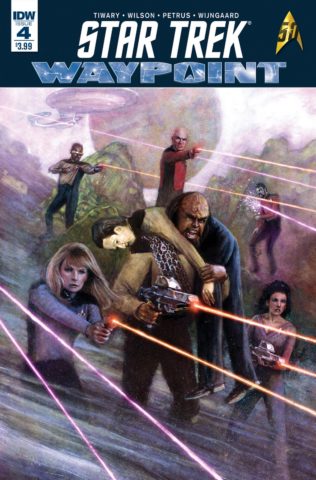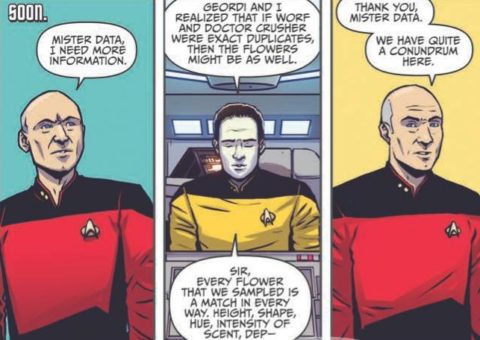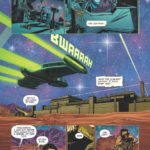Jonathan Archer and the NX-01 make their long-awaited funny book debut, while Picard and crew explore reflections and alternate realities. Reviews and 5-page previews for the two latest Star Trek comics.
REVIEW: STAR TREK WAYPOINT #4
We continue the bi-monthly voyages of the Prime universe in Star Trek: Waypoint #4 with two new short stories. First, a quiet nod to the acclaimed animated series episode “Yesteryear,” as writer Vivek J. Tiwary takes us to the near future of 2020, where a time-traveling Porthos goes “where no dog has gone before”, helping to save a pre-teen Jonathan Archer’s life from a Suliban. Next, a routine Away Team mission leaves Lt. Commander Worf and Dr. Crusher seeing double. And triple. And quadruple…
STAR TREK: ENTERPRISE – “THE FRAGILE BEAUTY OF LOYALTY”
Writer: Vivek J. Toward
Artist: Hugo Petrus
IDW gives us a worthy first entry to the comic adventures of Enterprise. Aside from a few discrepancies (Archer was actually born in 2112 and refers to his log as the Captain’s Starlog), it remains faithful to Star Trek lore. Artist Hugo Petrus’s gorgeous illustrations give us a look at a lush Schenectady County nature preserve. More importantly, he manages to accurately capture all of the action and emotion, proving that the bond between this man and dog can transcend time and space.
Our story begins with the Archers set to move to San Francisco, but before they do, a young Jonny Archer has one last mission in upstate New York. Disobeying his parents’ wishes, young Archer leaves his dog, Maska, behind. One thing you’ll notice is that there isn’t much dialogue and that’s a good thing. Petrus brilliantly pushes the story along with more show and less tell. The action sequences are suspenseful and I especially loved the close-ups – they really draw you in to what Archer is thinking.
The story seemed a bit rushed and could’ve used a few extra pages to flesh it out further. In fact, I wish that this story took up the entire book (more on that later). What Tiwary doesn’t manage to answer is the age-old question: why do villains leave the scene before their mission is accomplished? If the Suliban sent an agent back in time to kill Archer as a child, the least he could do is make sure he finished the job. I guess we’ll never know. As long as you don’t get bogged down with the messy details of time travel, you’ll enjoy it as much as I did.
STAR TREK: THE NEXT GENERATION – “MIRROR, MIRROR, MIRROR, MIRROR”
Writer: Scott Bryan Wilson
Artist: Caspar Wijngaard
The law of gravity states that what goes up must come down and that’s the best way to describe the second story. We fast forward to the 24th century with Scott Bryan Wilson’s redundant “Mirror, Mirror, Mirror, Mirror,” which is a letdown from the get-go. Any time you have Worf smelling a flower and not drinking prune juice, you know you’re in trouble.
The Enterprise is on a mission to synthesize a cure for a plague on a nearby Federation colony. Dr. Crusher and Worf are sent to investigate a certain flower that may hold the cure, but instead, they encounter a replicating mirror that copies whatever it sees in its reflection.
Not only was the premise confusing, but the resolution leaves much to be desired (see “Martha” in Batman v Superman: Dawn of Justice). Dr. Crusher realizes that if she beams down her Nana’s mirrors from the Enterprise and positions herself between two of them, she’ll be reflected into infinity. This apparently disrupts the (perhaps?) sentient mirror’s reflections of Dr. Crusher and Worf.
The only saving grace is the artwork, which is adequate in a cartoon-ish sort of way. Casper Wijingaard did the best he could do with the art under the circumstances. Unfortunately, this story, unlike the first one, suffers from too much tell, which is ultimately its downfall. A convoluted plot mixed with a babbling Data, and eight to ten Dr. Crushers talking simultaneously is a recipe for disaster.
And can someone tell me what happened to the rest of Picard’s command pips??
REVIEW: STAR TREK – DEVIATIONS ONE-SHOT
Writer: Donny Cates
Artist: Josh Hood
A year removed from IDW’s successful series of “what if” comics, they are back in a big way with the second annual Deviations five-week event series, with “alt-world” stories from various IDW titles. Today marks the release of the first-ever Star Trek: Deviations.
Writer Donny Cates (God Country) recounts the challenges of writing this story, originally meant to be a fun, action movie trope of “what if TNG was rebooted instead of TOS”, with Riker as a Snake Plisken-type hero on a ravaged earth. After back-and-forth with editor Sarah Gaydos, they pivoted to a more original “Romulans made first contact” deviation and he was off and running.
Picking up sometime in the 24th century, we are immediately thrust into a post-apocalyptic earth straight out of Mad Max. Of course, one can’t help but point out the similarities to the Argo scene in Nemesis, complete with a certain severed android head (with a touch of First Contact human skin). Geordi, still blind, has figured out a way to see by wiring his brain to Data’s positronic brain to see out of his eyes but hilariously doesn’t know what a transporter is. Worf is a pacifist and Deanna (with a Major Kira haircut) is the bad-ass second in command of the resistance. Their mission is to infiltrate a Romulan prison to rescue the man that can lead them to a mythical star base – a tortured, Shakespeare-loving Jean-Luc Picard.
Josh Hood’s artwork is superb with exquisite attention to detail, from the ridges on Worf’s forehead to Riker’s calloused hands. He manages to realistically capture the emotional connections these characters have with each other, even if some are meeting for the first time. He doesn’t get the likenesses of the actors quite right every time, but when he does, he absolutely nails it. Take a look at Jonathan Frakes’ signature grin – it’s totally worth it.
One of the advantages of doing a parallel universe story is that all of the rules of canon are out the window. You want to stay true to the core principles of the characters and the essence of Star Trek, but there are an infinite number of stories you can create. That said, I couldn’t get enough of this story. Cates puts a fresh new take on our beloved crew (except poor Wesley) and nails Riker, a character he vigorously studied. At first I thought that it was going to be a straight parallel universe story with no ties to the prime universe, but I was delighted to see that with the introduction of the Starfleet insignia, they knew something wasn’t right and began fighting for a life they should’ve had (see “Yesterday’s Enterprise”). I really enjoyed this story and would love to see it continue in future issues.
Cates could’ve told any story he wanted but chose to tell one he felt he HAD to – one of hope. Specifically, Gene Roddenberry’s hope for the future. Hope that we can all set aside our differences for the betterment of mankind. Hope that all war and disease will be eradicated so we can focus on scientific advancements that benefit all people. Star Trek has always served as an allegory to modern times so it’s no wonder Cates was inspired to write this story on November 9th, 2016. Politics aside, this was a wonderfully inspirational story and another must read for any Star Trek fan.
Star Trek: Waypoint #4 was released March 8th, and Star Trek: Deviations was released today, March 15th.
5-PAGE PREVIEWS (click thumbnails to enlarge)
Star Trek: Waypoint #4
Star Trek: Deviations
Keep track of the TrekMovie.com comics category for all the latest.























Nice. Just read Deviations, you nailed it. The art is spot on and storey was a great one shot
Shouldn’t the Archer story take place in 2120? According to Memory Alpha he was born in 2112.